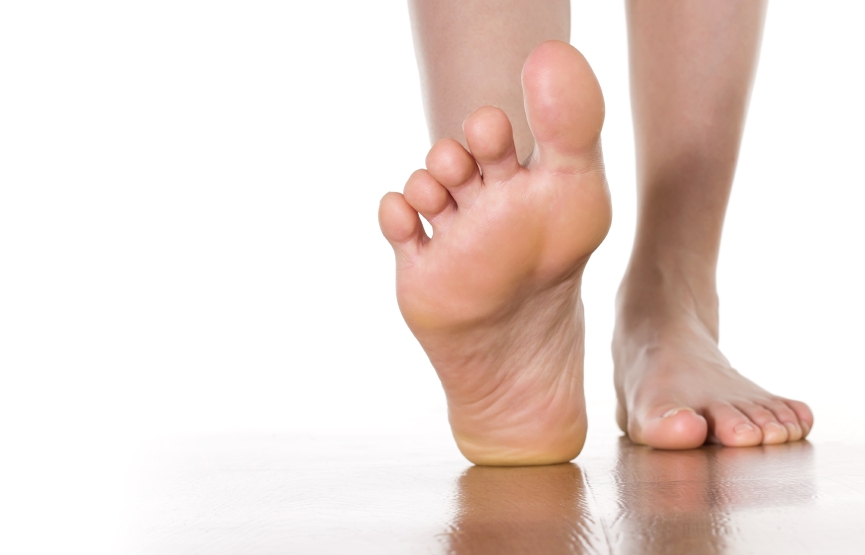They keep us grounded, get us where we need to go and bear the brunt of exercise, but instead of treating our feet with the attention they deserve, we often sacrifice the health of our feet. Here are some of the most Common Foot Injuries, Lumps and Bumps that we treat at the Forest Podiatry.
Heel Pain
Heel pain caused by plantar fasciitis is a very common foot problem. Pain will occur upon arising in the morning or when standing up after prolonged sitting. The plantar fascia is a strong fibrous band of tissue that originates in the heel and runs toward the ball of the foot. The plantar fascia helps to stabilize the arch. The problem begins when there is stress applied to the plantar fascia due to a biomechanical abnormality or instability.
Management of the injury is difficult because every step you take will stretch the plantar fascia and aggravate the problem. Treatment consists of pain management, a stretching program, compression support and possibly orthotic devices as well as a thorough gait analysis to uncover the underlying biomechanical cause of the injury.
Achilles Tendonitis
The Achilles tendon is located in the back of the lower leg and connects the calf muscles to the heel bone. The tendon can become less flexible and small tears can occur due to overuse. This overuse damage can occur gradually over time or immediately due to a one time trauma. The Achilles tendon has a poor blood supply therefore Achilles tendinopathy should not be left untreated because it is slow to heal. The signs and symptoms of Achilles tendinopathy usually develop over time. Repetitive stress over time will cause partial tears in the tendon which can lead to a complete tear.
The signs and symptoms of Achilles tendinopathy include:
- Pain and stiffness just above the heel in the back of the lower leg during or after activity;
- Decreased strength and mobility in the lower leg; and
- Severe pain usually in the morning.
If you have any of these signs or symptoms you should discontinue any activity that is aggravating the pain. A Podiatrist will be able to identify the cause of the overuse on the tendon as well as implement a treatment regime to heal and strengthen the Achilles tendon.
Toenail Fungus
Fungal nail disease can spread quickly, cause unsightly nail discoloration and contribute to a negative self-image. It may result in pain when wearing shoes, by developing corns down the sides of the nail or ingrown nails. Nearly 15% of Australians suffer from fungal nail disease.
What are the symptoms?
- Thickened, brittle toenails, some even become so thick that they cramp the toes inside the shoes.
- Yellow, brown or white toenail discoloration, depending on the type of fungi
- Yellow or brown fungus tends to overgrow and crumble the nail plate, with debris buildup under the toenail.
- White, superficial fungus lies on the top surface of the nail, softening it, then it dries up and becomes powdery.
- Unpleasant smell.
- Infection is spreading to other toenails or the skin.The Forest Podiatry is having great success fighting fungal infection using the FOX 1064 Laser. The FOX 1064 laser is Australia’s newest, fastest and most advanced technology to treat a fungal nail infections. The laser heats up the nail to a temperature of around 45?, which is enough to kill the fungal spores. As the laser beam heats through to the nail bed, it effectively treats the condition at its source. This is its greatest advantage over traditional therapies. You will feel a mild to moderate heat sensation which lasts one to four minutes per toenail.Corns or Calluses
Corns and callus are areas of a build-up of dead skin leading to thick, hard skin. They usually develop due to rubbing or irritation over a boney prominence.
Callus is formed in response to compressive stress being applied to the skin. A corn is an area of callus which is complicated by a deep central mass or nucleus of cornified cells. This nucleus of cells presses on the nerve endings causing pain. Corns can be caused due to the contraction or compression of the toes. The toes may be gripping due to an underlying biomechanical foot fault or take on this position because of tight shoes. Once the cause of the callus or corn is addressed, the callus or corn may only have to be removed mechanically on a bi-monthly basis.
Article written by Sophia Hennessy & Ashley Johnston (Podiatrists at The Forest Podiatry)
For further information please visit www.forestpodiatry.com.au

